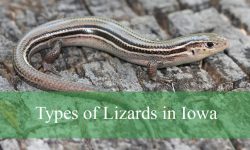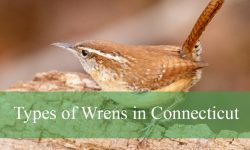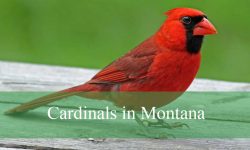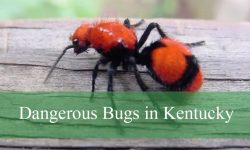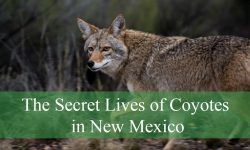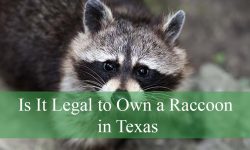Indiana’s forests and farmlands host a captivating variety of deer species, each bringing its own story to the state’s natural landscape. These graceful mammals can be seen roaming wooded hills, feeding near open fields, or quietly resting along shaded streams. Among them, the White-tailed Deer stands as the most iconic and widespread, while a few other native and exotic species add diversity to Indiana’s wildlife heritage.
Deer play an essential role in maintaining the balance of local ecosystems. They influence plant growth, serve as prey for predators, and help sustain the natural cycle of forest renewal. Their ability to adapt to changing environments has allowed them to thrive not only in wild habitats but also near suburban and agricultural areas.
This detailed guide explores five types of deer found in Indiana, highlighting their distinct features, size, habits, diet, breeding behavior, and distribution. It provides valuable insights for anyone interested in understanding these remarkable animals.
Types of Deer Found in Indiana
White-tailed Deer (Odocoileus virginianus)
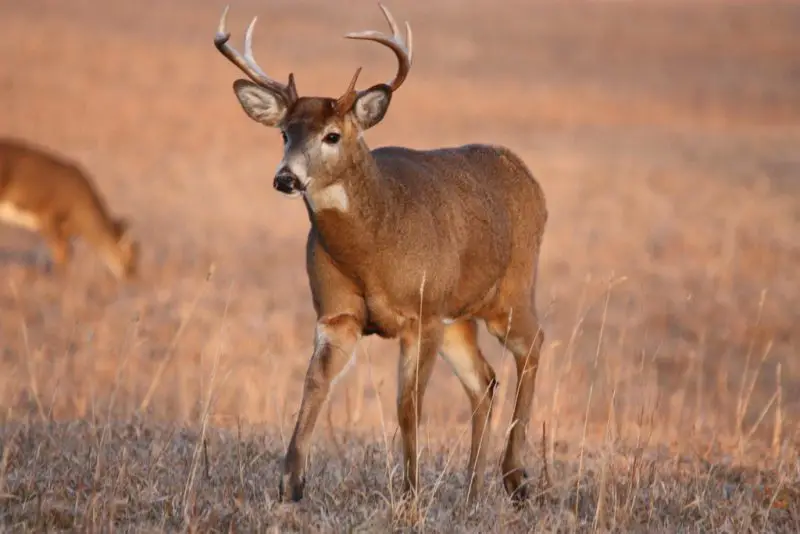
The White-tailed Deer is the most common and only native deer species found throughout Indiana. It is easily recognized by its reddish-brown coat during summer that turns grayish-brown in winter, and the distinctive white underside of its tail, which it raises when alarmed. Adults typically have a sleek body with long, slender legs and a narrow face. Bucks (males) grow antlers that branch outward and upward, shedding them each winter and regrowing them in the spring. These antlers play a vital role in dominance displays and mating rituals.
In terms of size, adult White-tailed Deer in Indiana usually weigh between 100 to 300 pounds, with males being significantly larger than females. Their shoulder height ranges from 3 to 3.5 feet, and their body length can reach up to 6 feet. Despite their size, they are incredibly agile and can run up to 35 miles per hour, leap over 8-foot fences, and swim efficiently to escape predators. Their keen sense of smell and hearing make them highly alert and adaptable to a variety of habitats.
Behaviorally, White-tailed Deer are crepuscular, meaning they are most active during dawn and dusk. They are social animals, with females often traveling in small family groups while adult males tend to be solitary outside of the breeding season. During fall, bucks enter the “rut,” a mating season characterized by aggressive behavior, sparring, and increased activity as they search for receptive females. This period also increases their visibility to hunters and wildlife observers.
Their diet mainly consists of leaves, twigs, fruits, nuts, grasses, and agricultural crops such as corn and soybeans. In Indiana, they are known to feed heavily on forest edges, farmlands, and suburban gardens. Seasonal changes influence their food sources, with green vegetation favored in spring and summer, and woody browse becoming more important in winter. Their foraging habits play a key role in shaping local vegetation communities.
White-tailed Deer populations are widespread across Indiana, found in nearly every county. They thrive in mixed woodlands, farmlands, and river valleys, particularly in areas with abundant cover and nearby water sources. Indiana’s deer management programs help balance their numbers, ensuring sustainable hunting and minimizing vehicle collisions. Today, they remain a symbol of Indiana’s rich natural heritage and are one of the most observed mammals in the state.
Elk (Cervus canadensis)
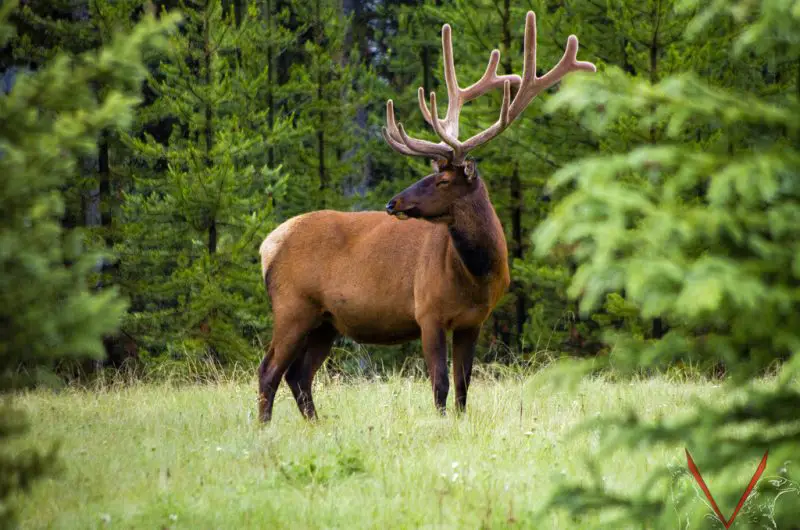
Elk, also known as Wapiti, were once native to Indiana but disappeared from the state by the mid-1800s due to overhunting and habitat loss. They are one of the largest members of the deer family, second only to moose. Adult males, called bulls, are distinguished by their massive, branching antlers that can span up to 4 feet across, while females, or cows, lack antlers. Their coats are light brown with darker necks and legs, and a pale beige rump patch.
In terms of size, adult elk in their natural range can weigh 500 to 700 pounds for females and up to 1,000 pounds for males. Standing nearly 5 feet tall at the shoulder, they have a commanding presence. Their powerful build allows them to travel long distances in search of food and mates, and they are known for their loud, haunting bugling calls during the breeding season. This call is one of the most iconic sounds of autumn in areas where elk are still present.
Elk are primarily grazers, feeding on grasses, forbs, bark, and shrubs depending on the season. They are often found in open meadows, forest clearings, and along riverbanks. In captivity or managed reserves in Indiana, elk are provided with supplemental feed but still display natural browsing behavior. They require large areas of habitat with a mix of forest for cover and open fields for feeding.
The breeding season for elk occurs in late September and October. Bulls compete fiercely for dominance, using their antlers to battle rivals. After mating, females give birth to one calf in late spring or early summer after an 8.5-month gestation. Calves are born with spotted coats, which help them remain camouflaged in dense vegetation until they are strong enough to join the herd.
Today, there are no wild populations of elk in Indiana, though small herds exist in private game preserves and wildlife parks, particularly near the southern border and around the Hoosier National Forest region. Reintroduction programs have been successful in nearby Kentucky, which means that in rare cases, individual elk might wander into Indiana’s border counties. Still, they remain a managed and protected species within the state.
Mule Deer (Odocoileus hemionus)
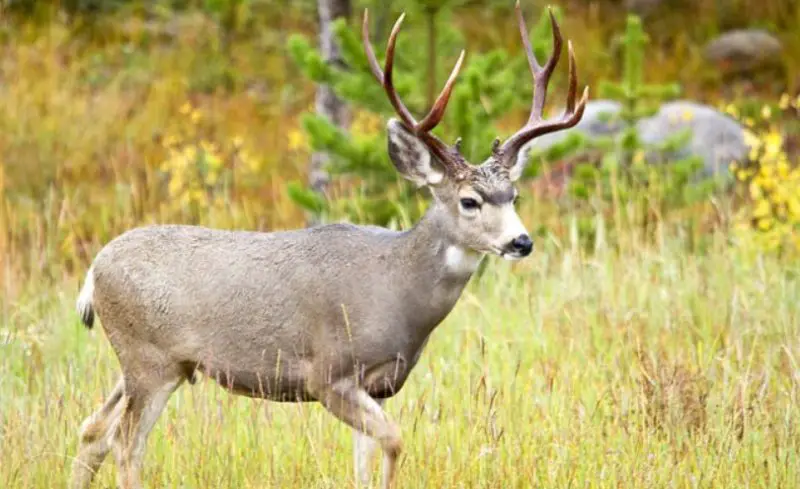
The Mule Deer, native to the western United States, is rarely seen in Indiana. Its name comes from its large, mule-like ears that are about three-quarters the length of its head. It has a stockier build compared to the White-tailed Deer, with a grayish-brown coat and a small, black-tipped tail. One of the most distinctive features is the bifurcated (forked) antler structure, where each tine splits into two, giving it a unique shape unlike the single-beamed antlers of White-tailed Deer.
Adult Mule Deer typically weigh between 130 to 280 pounds and stand around 3 to 3.5 feet at the shoulder. They are adapted to dry, open habitats, such as grasslands and shrublands, but have occasionally been reported in eastern states due to migration or accidental relocation. Their eyesight is exceptional, allowing them to detect predators and movement from long distances, and they are known for their characteristic bounding gait known as “stotting,” in which all four hooves hit the ground simultaneously.
Behaviorally, Mule Deer are mostly solitary or form small groups, especially outside of the breeding season. During fall, bucks engage in rutting behavior, using scent marking and antler sparring to establish dominance. They are less adaptable to human-altered environments compared to White-tailed Deer and prefer natural landscapes. However, some isolated reports suggest rare sightings of Mule Deer in southern Indiana, likely from captive populations or escaped individuals.
Their diet consists mainly of shrubs, twigs, grasses, and forbs, with seasonal variation. They are browsers rather than grazers, meaning they prefer woody plants and high-protein browse over grasses. Because of Indiana’s humid and forested conditions, Mule Deer would find limited suitable habitat compared to their western range, making survival in the wild here challenging.
While not part of Indiana’s native fauna today, occasional escaped or introduced Mule Deer may exist on private lands or ranches. There is no established wild population, and any observed individuals are considered rare vagrants. The state’s conservation agencies monitor reports carefully to ensure native species remain protected and ecosystems balanced.
Fallow Deer (Dama dama)
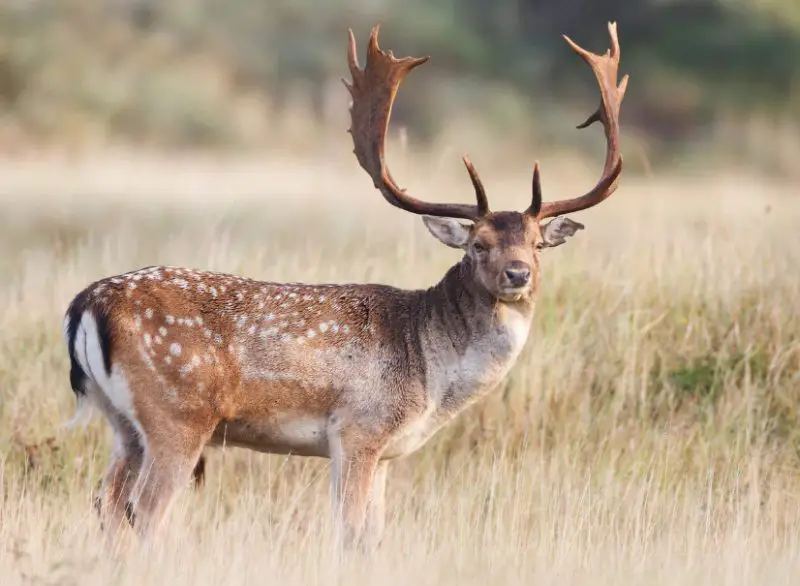
Fallow Deer are an introduced species in Indiana, primarily found in private hunting preserves and large estates. Originally native to Europe and parts of Asia, these deer are easily identified by their palmate (broad, flattened) antlers and their wide variety of coat colors, ranging from light fawn with white spots to dark brown or even black. Their bodies are compact and graceful, with a distinct black line running down their back to their white rump patch.
Adult Fallow Deer typically weigh 100 to 200 pounds and stand about 3 feet tall at the shoulder. Bucks grow broad, flattened antlers that resemble a moose’s antlers in miniature, while females are smaller and lack antlers entirely. They are well-adapted to a range of climates and can thrive in both woodlands and open fields. In Indiana, they are usually contained within managed areas where their populations are controlled to prevent escape.
Behaviorally, Fallow Deer are social animals that live in herds, especially during non-breeding seasons. Males establish small territories during the rut, which occurs in October, and use vocalizations, posturing, and sparring to attract females. They are generally less aggressive than White-tailed or Mule Deer, and their elegant movements make them popular among exotic game enthusiasts.
Their diet includes grasses, herbs, leaves, and agricultural crops, similar to that of other deer. They adapt easily to human-altered environments, often grazing in open pastures and woodland edges. In Indiana, they are typically fed supplementary grain and forage within enclosures, ensuring healthy growth and reproduction.
Though not native to the state, Fallow Deer populations exist in captivity across Indiana, especially in southern and central counties where private reserves operate. These populations are carefully monitored to prevent interbreeding with native deer and to maintain ecological balance. Occasional escapees may be spotted near rural woodlands, but none are considered part of a wild, self-sustaining population.
Red Deer (Cervus elaphus)
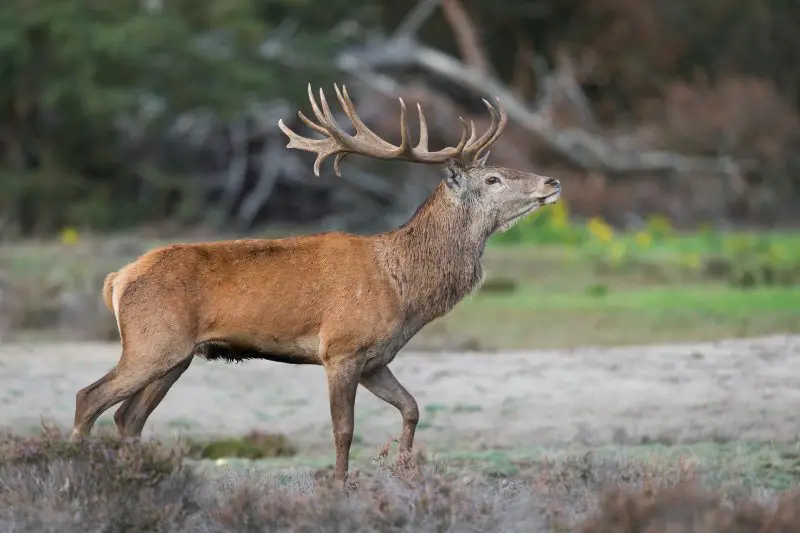
The Red Deer, a close relative of the North American elk, is one of the largest deer species found in captivity in Indiana. Native to Europe and Asia, it was introduced to North America for hunting and ornamental purposes. Red Deer have a reddish-brown coat in summer that darkens to grayish-brown in winter. Males develop impressive, multi-branched antlers that can weigh up to 30 pounds and are shed annually.
Adult Red Deer are massive, with males reaching 700 to 900 pounds and females weighing between 300 and 500 pounds. They stand up to 4.5 feet tall at the shoulder, giving them a commanding stature. Their powerful legs and muscular bodies allow them to cover long distances easily, and their deep, resonant roar during the rut is one of their most distinctive characteristics.
Behaviorally, Red Deer are herd animals. Males and females live separately for most of the year and only come together during the breeding season, which occurs in late September and October. During this time, stags compete for harems of females through roaring contests and physical combat. The gestation period lasts around 8 months, with females giving birth to a single calf in late spring.
Their diet consists of grasses, leaves, bark, and agricultural crops, making them adaptable feeders. They are grazers by nature but will also browse when necessary. In Indiana, they are maintained in enclosed areas where they are fed and managed for conservation, tourism, and hunting purposes. Their behavior remains largely natural even under managed conditions.
Red Deer are not native to Indiana, but they are found in private game farms, wildlife parks, and hunting estates across the state. They are closely monitored to prevent hybridization with elk, which can occur if both species are kept in proximity. Although they are not part of the state’s wild fauna, they contribute to Indiana’s wildlife diversity through regulated management programs and education initiatives.
Best Time and Place to See Deer in Indiana
Indiana offers abundant opportunities for deer observation, especially for those interested in wildlife photography, birding, or simply experiencing nature. The state’s diverse landscapes — from farmlands to forests — create perfect habitats for White-tailed Deer and even some exotic species in managed reserves.
Best Time of Year to See Deer
The best time to see deer in Indiana is during autumn and early winter, particularly from October through December. This period coincides with the rutting season for White-tailed Deer, when males are more active, vocal, and visible during daylight hours. Bucks move frequently in search of females, often appearing along forest edges, fields, and rural roadsides. Morning and evening hours provide the most reliable sightings, as deer are crepuscular — most active at dawn and dusk.
Spring also offers a unique viewing opportunity when does give birth to fawns. Between May and June, young fawns with white spots can occasionally be seen resting in tall grasses while their mothers feed nearby. However, it’s important to observe from a distance, as human disturbance can cause stress to both mother and offspring.
Best Places to See Deer in Indiana
Indiana’s state parks and wildlife management areas are prime spots for deer watching. Brown County State Park, often called the “Little Smokies,” is one of the most reliable locations for spotting herds, especially during early morning drives along forested roads. Turkey Run State Park and Shades State Park in western Indiana also provide wooded valleys and river corridors where deer are abundant.
In southern Indiana, Hoosier National Forest stands out as a premier destination. With over 200,000 acres of mixed hardwood forests, it supports one of the largest populations of White-tailed Deer in the state. Patoka Lake Wildlife Area and Monroe Lake are also known for regular sightings along hiking trails and shorelines. For those interested in exotic deer like Fallow or Red Deer, private preserves in Orange, Dubois, and Lawrence counties often allow guided viewing tours.
Tips for Watching Deer Responsibly
To increase your chances of observing deer, visit during the early morning or late evening, move quietly, and wear muted colors that blend with the environment. Avoid sudden movements and keep a respectful distance — deer are cautious and easily startled. Using binoculars or a zoom lens allows for detailed viewing without approaching too closely. During the rut, maintain extra caution, as bucks can be aggressive and unpredictable. Always respect private property and follow all wildlife and hunting regulations.
FAQs About Deer in Indiana
What Is the Most Common Deer Species in Indiana?
The White-tailed Deer is by far the most common and widespread deer species in Indiana. It thrives across all regions of the state, from dense forests to suburban neighborhoods. Other deer species like elk, mule deer, fallow deer, and red deer may be found only in captivity or managed reserves but are not native to Indiana’s wild ecosystems.
Are There Elk in Indiana?
Historically, elk were native to Indiana but were extirpated in the mid-1800s due to overhunting and habitat destruction. Today, there are no wild elk populations in the state. However, a few private ranches and wildlife parks maintain small herds for conservation and educational purposes. Nearby Kentucky’s successful reintroduction efforts have led to occasional sightings near the Indiana-Kentucky border.
Can You Hunt Deer in Indiana?
Yes. Deer hunting is legal and highly regulated in Indiana. The state’s Department of Natural Resources (DNR) oversees specific seasons for archery, firearm, and muzzleloader hunting. The main target species is the White-tailed Deer, with restrictions on bag limits and antlered/antlerless harvests to ensure population balance. Hunters must possess valid licenses and adhere to local regulations and safety protocols.
What Do Deer Eat in Indiana?
Deer in Indiana have a varied and seasonal diet. During spring and summer, they primarily feed on green vegetation, leaves, clover, fruits, and crops like soybeans and corn. In autumn, acorns and nuts become a crucial food source as they prepare for winter. When food is scarce in winter, they browse on woody stems, bark, and evergreen plants. Their flexible diet helps them survive across diverse environments.
When Is Deer Mating Season in Indiana?
The deer mating season, or rut, typically occurs from late October through early December in Indiana. During this time, bucks compete for mates by sparring with antlers and marking territories with scent. Increased movement and daylight activity make them more visible. After a 6.5-month gestation period, does usually give birth to one or two fawns in late spring.
Where Can I See Deer Safely in Indiana?
For safe and enjoyable deer viewing, visit state parks and nature preserves where wildlife observation is encouraged. Top locations include Brown County State Park, Hoosier National Forest, Turkey Run State Park, and Tippecanoe River State Park. These areas feature designated trails, scenic overlooks, and low traffic, allowing quiet observation of deer in their natural settings.
Are There Any Exotic Deer in Indiana?
Yes, but only in captivity or private preserves. Species such as Fallow Deer and Red Deer are maintained for ornamental or hunting purposes on fenced estates. These deer are not part of Indiana’s native ecosystem and are carefully managed to prevent escape and ecological disruption. Occasionally, individuals may be spotted near such facilities, but they do not form wild populations.
Do Deer Pose Any Dangers in Indiana?
While deer are generally peaceful animals, they can cause vehicle collisions, particularly during mating season when movement increases. Drivers should exercise caution during dawn and dusk, especially on rural roads. Bucks can also be aggressive during the rut, so it’s best to observe from a distance. Additionally, deer can carry ticks that transmit Lyme disease, so protective clothing is recommended when hiking in deer habitats.
How Big Do Deer Get in Indiana?
White-tailed Deer in Indiana vary in size depending on age, diet, and genetics. Adult males typically weigh 150–300 pounds, while females weigh 90–150 pounds. Mature bucks stand around 3.5 feet tall at the shoulder and can reach up to 6 feet in body length. Exceptional individuals may weigh even more in areas with rich food sources such as southern Indiana farmlands.
Are There Any Efforts to Protect Deer in Indiana?
Yes. The Indiana Department of Natural Resources actively manages deer populations to maintain ecological balance and reduce conflicts with humans. Conservation programs include regulated hunting, disease monitoring, and habitat management. Wildlife biologists also study deer behavior and migration to ensure long-term sustainability. Education initiatives promote coexistence and responsible observation practices among residents.
Conclusion
Indiana’s deer population offers a fascinating glimpse into the state’s wildlife diversity. From the ever-present White-tailed Deer to the occasional exotic species found in preserves, these graceful mammals play a crucial role in maintaining ecological balance. Whether you’re exploring the forests of southern Indiana or the open fields of the north, encountering a deer is a reminder of the natural beauty that thrives across the Hoosier landscape.
By understanding their habits, habitats, and seasonal patterns, both wildlife enthusiasts and hunters can appreciate these animals responsibly — ensuring that future generations continue to enjoy the sight of deer roaming freely in Indiana’s forests and meadows.

